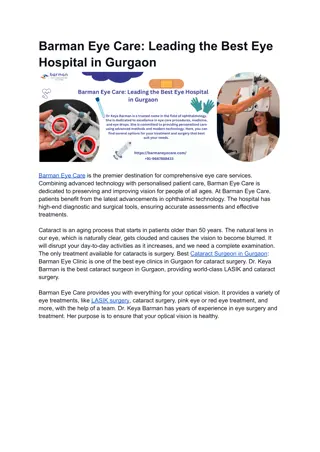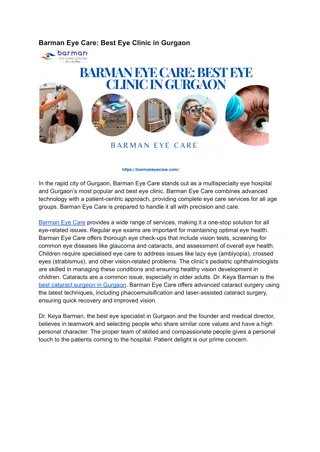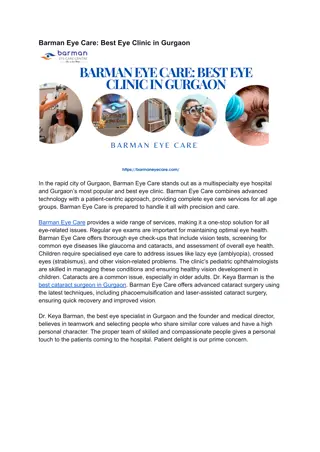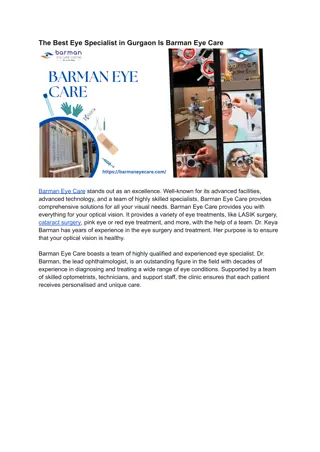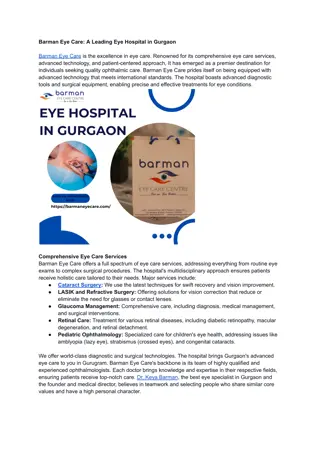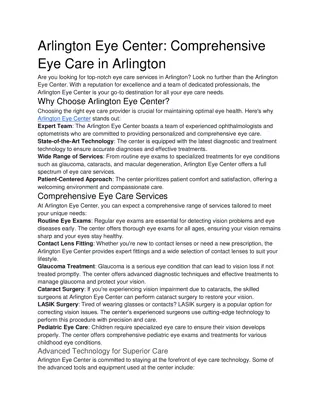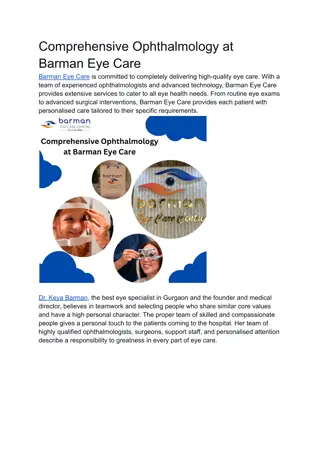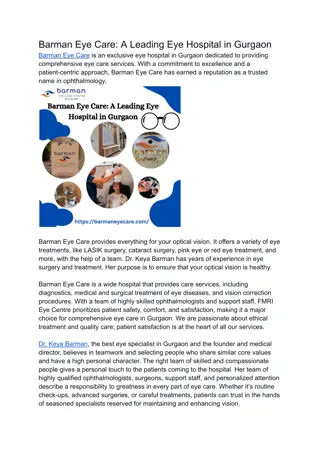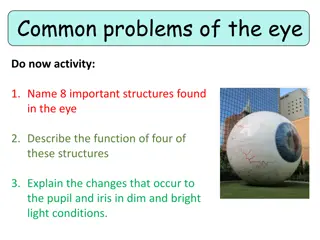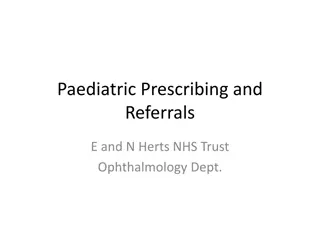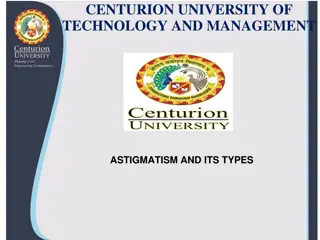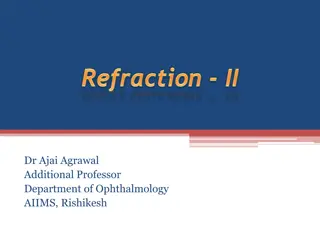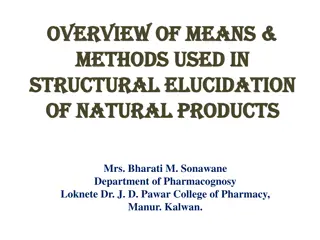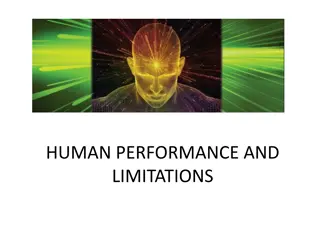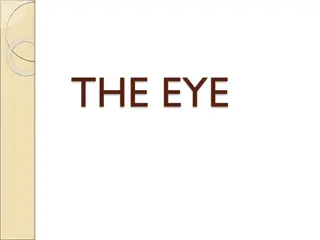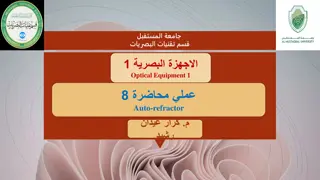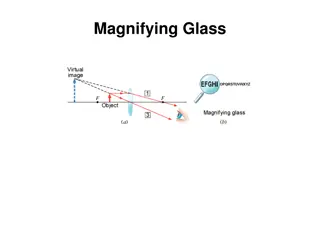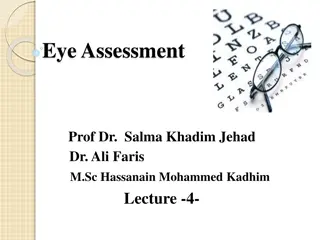Understanding Ametropia: Refractive Eye Conditions Explained
Ametropia refers to refractive errors in the eye such as myopia, hypermetropia, and astigmatism, where light rays don't focus correctly on the retina. This condition is influenced by corneal power, anterior chamber depth, crystalline lens power, and axial length. Hypermetropia, also known as hyperopia, results in distant objects being clearer than close ones. The etiology of ametropia can be related to axial length or curvature changes in the eye structure. Additionally, positional anomalies like posteriorly placed crystalline lens or absence of lens can contribute to refractive issues. Understanding these components is crucial for managing and correcting vision problems.
Download Presentation

Please find below an Image/Link to download the presentation.
The content on the website is provided AS IS for your information and personal use only. It may not be sold, licensed, or shared on other websites without obtaining consent from the author. Download presentation by click this link. If you encounter any issues during the download, it is possible that the publisher has removed the file from their server.
E N D
Presentation Transcript
CENTURION UNIVERSITY OF TECHNOLOGY AND MANAGEMENT HYPROPIA
AMETROPIA Ametropia is defined as a state of refraction wherein parallel rays of light coming from infinity ( with accommodation is at rest) are focused either infront or behind the sensitive layer of retina , in one or both the meridian. Ametropia includes the following- Myopia Hypermetropia Astigmatism
Components of ametropia The overall refractive state of the eye is determined by four component: Corneal power ( ranges from 40 to 45 D , mean 43.0 D ) Anterior chamber depth ( mean 3.4 mm ) Crystalline lens power ( ranges from 15 to 20D in its nonaccomodative state ) and Axial length ( mean 24 mm )
The term hyermetropia is derived from hyper meaning in excess met meaning measure and opia meaning of the eye . Also called hyperopia/ long sightedness First suggested in 1755 by KASTNER
DEFINITION It is the refractive state of eye where in parallal rays of light coming from infinity are focused behind the retina with the accommodation at rest The posterior focal point is behind the retina which receive a blurred image.
ETIOLOGY AXIAL Most common Total refractive power of eye is normal Axial shortning of eyeball 1mm short 3D of HM Physiologically more than 6D HM are uncommon.
CURVATURAL Flattening of cornia,lens or both 1mm increase in redius of curvature result in 6D of HM Never exceed 6D HM physiological Congenitally flattened (cornial plana) Result (truma and disease) INDEX Change in refractive index with age Physiological in old age
POSITIONALY Posteriorly placed crystalline lens Occurs as congenital anomaly Result of trauma or disease ABSENCE OF LENS Seen in aphakia
CLINICAL TYPES Simple hypermetropia Pathological Functional hypropia 1. 2. 3.
SIMPLE HYPERMETROPIA Commonest form Result from normal biological variations in the development of eye ball Include axial and curvatural HM May be hereditary
PATHOLOGICAL HYPERMETROPIA Anomalies lie outside the limits of biological variation Acquired hypermetropia Decrease curvature of outer lens fibers in old age Cortical sclerosis Positional hypermetropia Aphakia Consecutive hypermetropia
FUNCTIONAL HYRERMETROPIA Result from paralysis of accommodation Seen in patients with 3rdnever paralysis and internal ophlthalmoplegia
NOMENCLATURE Total hypermetropia =latent +manifest (facultative +absolute)
TOTAL HYPERMERTOPIA It is total amount of refractive error estimated after complete cycloplegia with atropine Divided into latent and manifest
LATENT HYPERMETROPIA Corrected by inherent tone of ciliary muscle Usually about 1D High in children Decreases with age Revealed after abolishing tone of ciliary muscle with atropine
MENIFEST HYPERMETROPIA Remaining part of total hypermetropia Correct by accommodation and convex lens Measure by add strongest lens with max.vision FACULTATIVE HYPERMETROPIA Corrected by patients accommodation effort ABSOLUTE HYPERMERTOPIA Residual part not corrected by patients accommodation
Absolute hypermetropia can be measured by the weakest convex lens with which maximum visual acuity Manifest HM-absolute HM =facultative HM (strongest lens )-(weakest lens) Total HM manifest HM=latent HM
SYMPTOM Principal symptom is blurring of vision for close work Symptom vary depending upon age of patient and degree of refractive error ASYMPTOMATIC Small error produces no symptom Corrected by accommodation of patient
ASTHENOPIA Refractive error are fully corrected by accommodation effort Thus vision is normal Sustained accommodation produces symptoms Asthenopia increases as day prograsses Increased after prolonged near work
DEFECTIVE VISION ONLY Refractive vision more than 4D Adults usually do not accommodation Marked defective vision for near and distance
SIGNS Visual acuity :defective Eye ball : small or normal in size Cornea : may be smaller then normal .There can be cornial plana Anterior chamber : may be shallow Lens : could be dislocated backwords A scan ultrasonography (biometry) reveal short axial length
COMPLICATION Recurrent styes m blepharitis or chalazia Accommodative convergent squint Amblyopia Predisposition to develop primary narrow angle glaucomas
MADE OF TREATMENT Spectacles Contact lens surgical
REFRACTIVE SURGERY Refractive surgery is not as effective as in myopia TYPES Hexagonal keratotomy (HK) Laser thermal keretoplasty (LTK) Photorefractive keratectomy (PRK)


